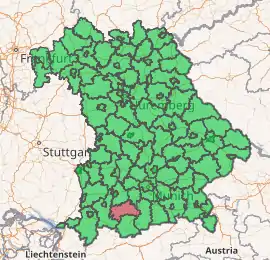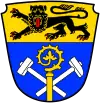Weilheim-Schongau
Weilheim-Schongau is a Landkreis (district) in the south of Bavaria, Germany. Neighboring districts are (from the north clockwise) Landsberg, Starnberg, Bad Tölz-Wolfratshausen, Garmisch-Partenkirchen and Ostallgäu.
Weilheim-Schongau | |
|---|---|

| |
| Country | Germany |
| State | Bavaria |
| Adm. region | Upper Bavaria |
| Capital | Weilheim |
| Area | |
| • Total | 966.22 km2 (373.06 sq mi) |
| Population (31 December 2019)[1] | |
| • Total | 135,478 |
| • Density | 140/km2 (360/sq mi) |
| Time zone | UTC+01:00 (CET) |
| • Summer (DST) | UTC+02:00 (CEST) |
| Vehicle registration | WM, SOG |
| Website | http://www.weilheim-schongau.de |
Geography
The district is located in the northern foothills of the Alps. The main rivers of the district are the Lech and the Ammer. The Ammersee and the Starnberger See are at the northern boundary of the district.
History
The district was formed in 1972 by merging the former districts Weilheim and Schongau, and one municipality from the former district Marktoberdorf.
Coat of arms
 |
The coat of arms combines the symbols of the two precursor districts. The lion in top as the symbol of the Hohenstaufen dynasty was taken from the coat of arms of the district Weilheim. The crosier and the mining tools in the bottom are derived from the coat of arms of the district Schongau, symbolizing both the important monasteries as well as the coal mining in the district. |
Towns and municipalities

Towns and municipalities in Landkreis Weilheim-Schongau
| Towns | Municipalities | |
|---|---|---|
|
|
References
- "Tabellenblatt "Daten 2", Statistischer Bericht A1200C 202041 Einwohnerzahlen der Gemeinden, Kreise und Regierungsbezirke". Bayerisches Landesamt für Statistik und Datenverarbeitung (in German). July 2020.
External links
| Wikimedia Commons has media related to Landkreis Weilheim-Schongau. |
- Official website (German)
This article is issued from Wikipedia. The text is licensed under Creative Commons - Attribution - Sharealike. Additional terms may apply for the media files.
